Financial District
Who the hell looks up in this town? Who has time? (David Zickerman)
The famous financial district, the jungle of skyscrapers, is in the southern part of Manhattan. You must visit it on a weekday as it’s depressingly empty during weekends and without businessmen rushing about the area loses its vibe.
Now a paragraph with some history: Native Americans were living in Manhattan’s forested areas until in 1626 a Dutch fur trading outpost was established in Lower Manhattan named New Amsterdam. The same year Peter Minuit purchased Manhattan from the local Native Americans for a few objects (current value about $1000) in a small park called Bowling Green. The only original document about the purchase is in the Dutch National Archives in The Hague. The first settlers started to build helter-skelter that’s why the streets in the lower area are still winding and not straight. In 1664 an English fleet took the city without a battle and renamed it New York (in honour of James, Duke of York who was the younger brother of the English king). The British lost the territory in 1783 during the American War of Independence but the name stuck.
Let’s start our walk in the southern corner, in Battery Park. Clinton Castle stands here which is mainly known for the small kiosk in the middle of it selling tickets for the boats going to the Statue of Liberty. The castle was built not to surround the little kiosk but in 1812 when there was some tension with England. After the threat of war was gone the fortification was turned into an open-air theatre and later was covered and functioned as a concert hall. Originally it was partly built into the sea but in 1855 they managed to fully join in up with the shore using soil dug up by the nearby constructions. For a long time famous visitors to the city were received in this hall, for example in 1851 Americans sympathetic to the Hungarian freedom fight welcomed Lajos Kossuth here. From 1855 to 1889 it was used as the arrival centre for immigrants, the role later taken over by Ellis Island. Then the New York Aquarium moved here but not long after moved out to its current location on Coney Island. So the solitary fortress stands empty since then. In 1950 it got listed and by removing the roof was turned back to its original form. Walking east from Castle Clinton we find a large sculpture, the East Coast Memorial. The huge eagle standing behind two rows of granite columns is in memory of the seamen who died in the WWII. Further east is really ugly green glass building, the Staten Island Ferry Terminal.
Tip: if you have no time or money to take a boat to the Statue of Liberty you can get on a ferry to Staten Island. The ferry sails fairly close to the statue and you can take excellent photos all for free – even the earlier laughably cheap 50 cent ferry ticket was abolished in 1997.
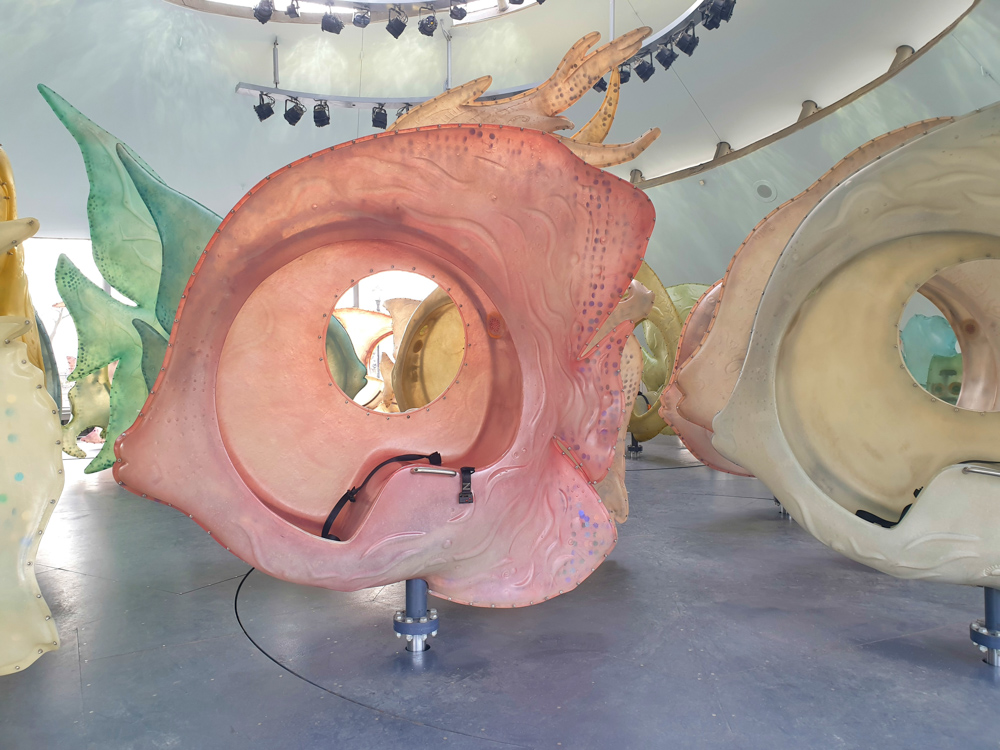
Translation results
Governor Island, also visible from Battery Park, was a military fortress and prison and today is a museum and favoured place for excursions.
Starting north from the ferry terminal on Water Street we found a cute little garden by number 55, the Elevated Acre from where there is a nice view to the river and the nearby heliport.
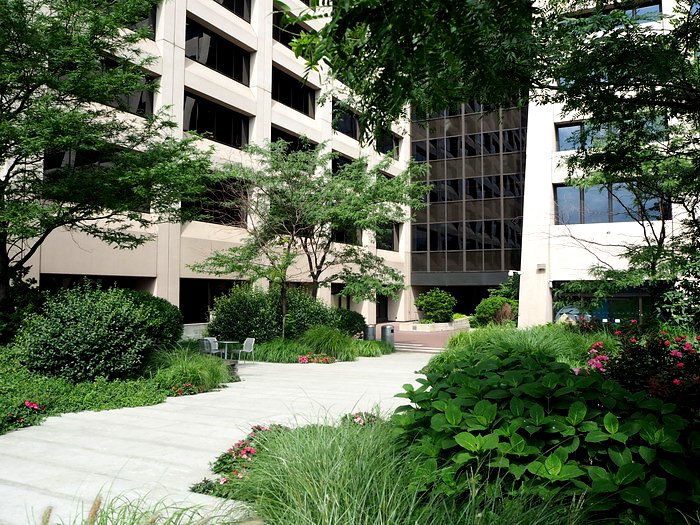
It’s worth taking a small detour towards Stone Street because it’s one of the few streets where the original cobble stones are still in place.

North from the ferry terminal is State Street, the northern border of the park. At the end of this street, across the small Bowling Green Park stands a large beautiful building, the U.S. Customs House. The one-time customs house is now home to the Museum of the American Indian. The four grandiose statues represent four continents. The arm of sleeping Africa is resting on a sphinx, confident Europe is proudly watching the traffic, America is just getting up from an armchair holding the torch of liberty while Asia is sleeping on skulls. This museum is also home to the collection of the National Archive where anyone can search for free to see whether they have ancestors among the immigrants or if they have been mentioned in some other documents.

Bowling Green is the city’s oldest park and used to be a cattle market and later a bowling green (hence the name). In this small oval shaped park the fence is what is worth to look at more closely. The low iron fence is from 1771 and was made in England. Small crowned heads (figures of the royal family) adorn the top of the iron bars and these were damaged by the crowds during the 1776 revolution.
There is a large bull nearly across the museum with various legends surrounding it. My favourite story is that the bull, which represents rising stock prices, was erected one night by a sculptor who lost money on the stock exchange. The bull became part of the city scape over the years. Then the sculptor told the city they either pay him money for the work or he would sell the statue somewhere else. By then everyone loved it so they paid and the artist got back the money he lost. What we know for sure is that statue was placed in front of the stock exchange by sculptor Arturo di Modica with thirty of his friends in the middle of the night on the 15th of December, 1989. Later it taken away due to lack of permission and obstruction of traffic but the uproar that followed ensured a place for it on Broadway.

So Broadway. The street was originally a Native American pathway, then a cart-way so it was Manhattan’s main artery from the start. It was designed to be totally straight but there a few breaks in the line such as where a Dutch alderman didn’t allow his trees that were in the way to be cut. Broadway with its 38 km length is one of the longest city street in the world.
Among the corporate offices and banks let’s set the course to Wall Street, the heart of the financial world. Wall Street – how surprising – was named after a wall which stood here in 1653 to defend the Dutch settlers from the English invaders. But the present is important here not the past. The New York Stock Exchange is on Wall Street, its every quaver watched by thousands over brokers all over the world. Before 1792 trades in stocks were pretty disorganized on Wall Street but that year 24 brokers, standing under a plane tree in the street, agreed to only trade with each other thus founding the base for the stock exchange. The first office and a written charter was only established in 1817. The current building opened almost a century later in 1901. Unfortunately visiting the stock exchange was halted indefinitely for security reasons.
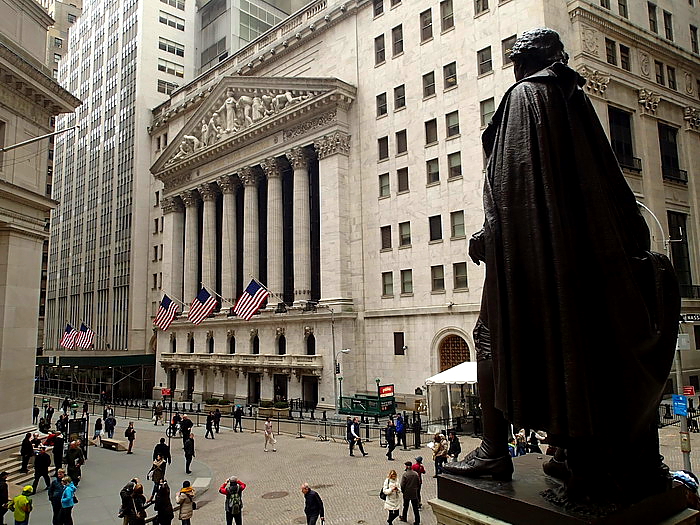
In March 7, 2017 a new statue was placed right in front of the NYSE building, in anticipation of International Women’s Day the following day. The Fearless girl promotes female empowerment.
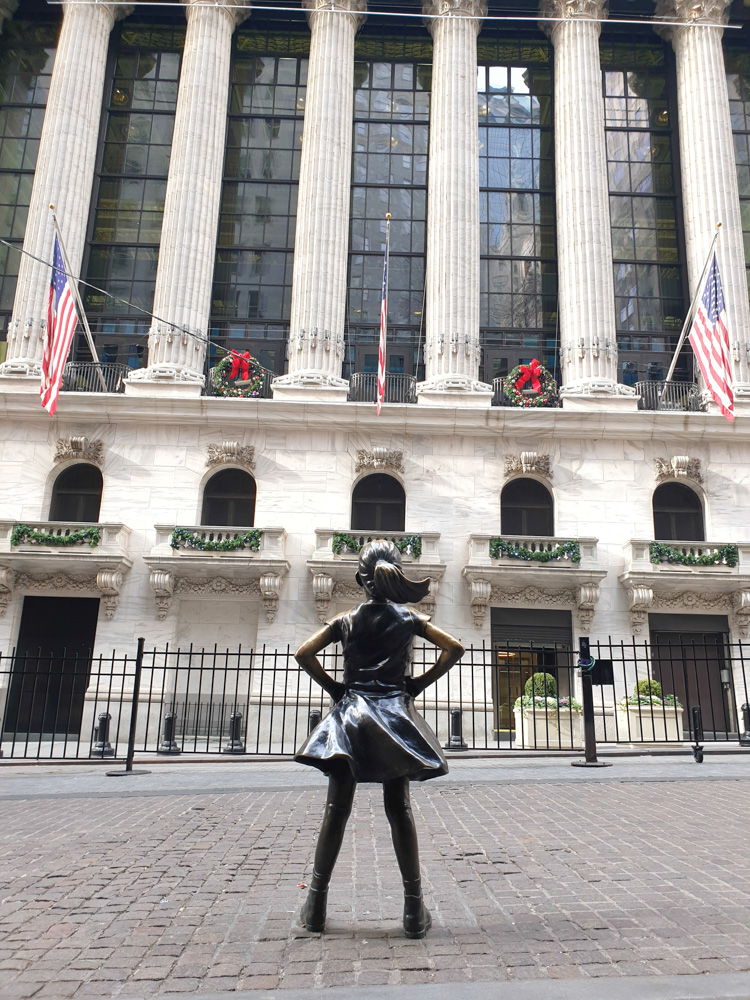
Across the stock exchange is the Federal Hall with a statue of George Washington in noticeably tight trousers. The first president of the country swore in here. The imposing building was renovated in 2006. Let’s look inside the rotunda and then sit on the stairs to watch the flow of the crowds. Maybe the best is to come in the morning, around half past 8, when the employees are rushing to work. People are streaming out of the metro stations in suits holding briefcases and the Wall Street Journal and quickly disappear in the entrances to the skyscrapers. At 9 the street empties and the narrow ravine of Wall Street quiets down. At noon the bustle is back and we can sit on the stairs on the sun next to the brokers and we can eat our lunch together from the typical brown bags.
At the end of Wall Street stands the Trinity Church, a gothic church built in 1846. The small church is intimidated by its giant neighbours even though hundred years ago it was the tallest building in the city. In the summer, there are concerts organized in its garden and Sunday afternoons it hosts classical concerts. Poor thing has to watch people chasing the money all day long. It can’t be easy for the priest to withstand temptation. I bet there were several companies offering huge checks for the prime real estate.
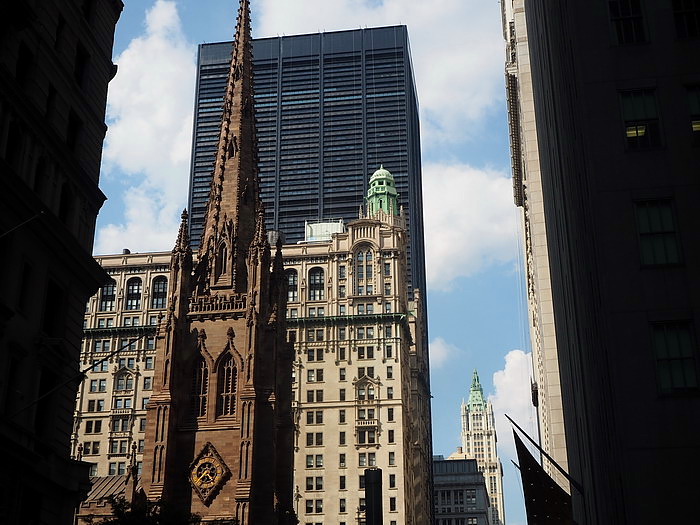
The museum commemorating the tragedy, the Ground Zero Museum, can be found north of here on the 14th Street between 9th Avenue and Washington Pl. There is a memorial in place of the twin towers, entrance is free.
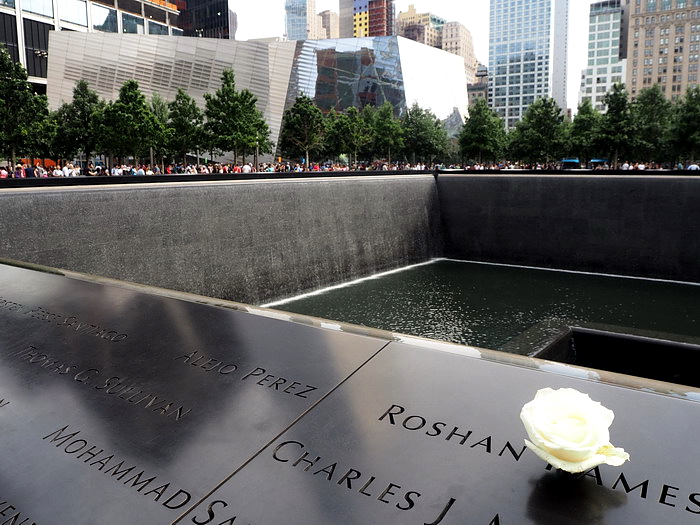
In place of Six World Trade Center there is now the brand new 104 storied One World Trade Center which was given the ‘building number’ of the twin towers. Currently it’s the tallest building in the U.S.
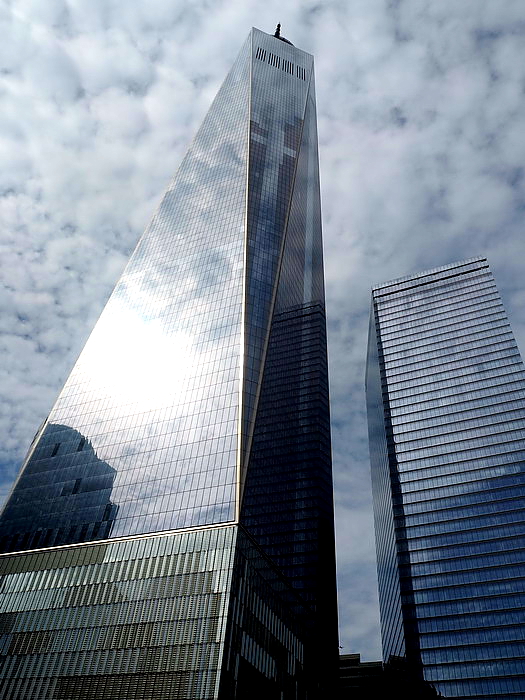
There is an excellent view point on top of the building and getting up there is already an experience since there is a time lapse video playing in the elevator about the development of the city.
The view is fantastic! The only issue is that there is no open space and it’s hard to avoid the reflections on the glass in sunny weather.
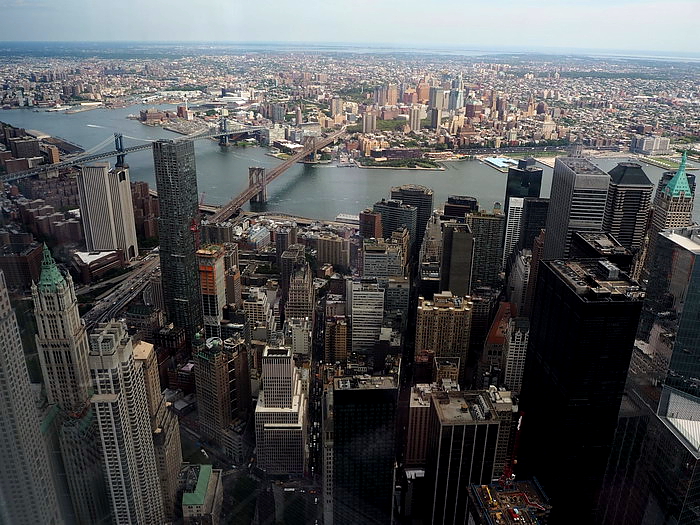
Do not miss the subway station, Oculus at this point – amazing!
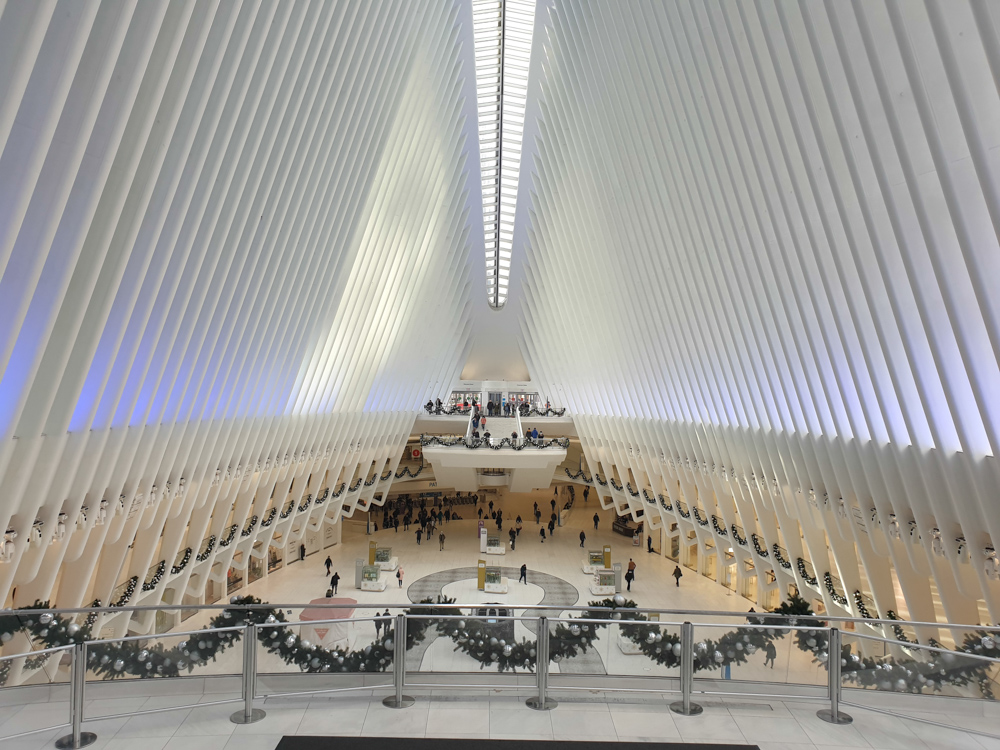
Finally you can visit New York’s port, the South Street Seaport. Expensive shops, loads of tourists and no real atmosphere. Until 2006 there was a fish market here in the mornings but that moved to the Bronx. It’s not an exciting place, only those should go here who have seen everything else in the city.
Civic Center
There are lots of city and federal government buildings around City Hall. If we start from the World Trade Center, first I would like to call attention to the building of the Federal Reserve Bank of New York (33 Liberty Street).
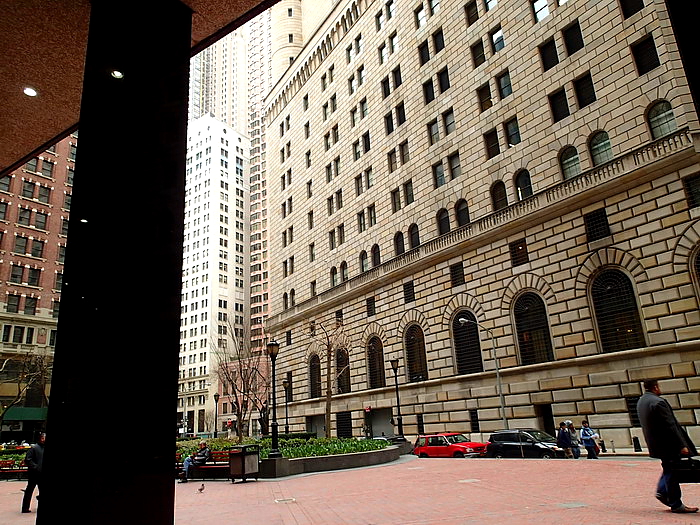
The city block-wide, Italian palace like building was decorated with more than 200 tonnes of iron. It’s a pretty secure bunker. And there is a reason for building a fortress: enormous amounts of gold are held here. About 7000 tonnes (a value of appr. $360 billion, 20% of the world’s gold reserve) which is probably the largest gold reserve in the world (we cannot know for sure because the Swiss banks don’t publish their information). 98% of the gold belongs to other countries as the U.S. stores its own in Fort Knox. The gold reserves here are also to secure trades between countries. When two countries settle trade balances the 99.8% pure gold bars simply moved to the appropriate cages. There are 122 cages, most countries rent one but there are some countries that need more than one. It’s worth look at the shoes of the people who move the gold around: they wear special magnesium slippers worth $500 each because it wouldn’t be pleasant if a gold bar fell on their toes. Beside that they move the bars by hand the usage of mechanical scales is also surprising but there is no digital scale which could be used for weighing very tiny and also huge quantities of gold. Here sometimes they pack the scale with bars weighing 12-13 kg other times only very small quantities need to be measured. They told us about the precision of the mechanical scale that if you rip a dollar bill into 3, a one third piece will measure two lines on the scale. The whole cellar is defended by a very heavy door which is air and watertight. It’s estimated that if someone would get stuck in the cellar they would stay alive for about two days before the oxygen would run out. The cellar full of gold can be visited but it’s not straightforward. You have to book online a month ahead, the tours fill up quickly. I managed to beg my way in but it wasn’t easy. The tours are an hour long and free and I can truly recommend them.
The next sight is the St Paul’s Chapel (by the corner of Fulton Street and Broadway), a small church built in 1766 the only surviving one from before the war of independence. Luckily it was not damaged during the 2001 tragedy. Inside it’s like the colour of baby clothes – pastel blue and pink.
From here it’s a short walk to the Woolworth Building (233 Broadway), the cathedral of commerce, one of the prettiest skyscrapers in the city. Shop assistant, Frank Woolworth opened a new type of store in 1879 where he introduced two innovations that were revolutionary at the time. He worked with fix prices (5 cents) instead of bargaining and shoppers were not only served by assistants but could also in a self-serve kind of way take the products themselves. The first small shop transformed commercial practices and made Woolworth fabulously rich. It’s worth peeking into the foyer where beautiful blue, green and gold mosaics adorn the ceiling. In one corner there is a caricature of Woolworth counting his pennies and in the other the architect Cass Gilbert is holding a model of the building. In the entrance hall even the letter boxes are works of art. If someone wants to explore the building in more detail – which I recommend as it is very interesting – they should take part in a guided tour which provides ample information about the building as well as the story its owner.
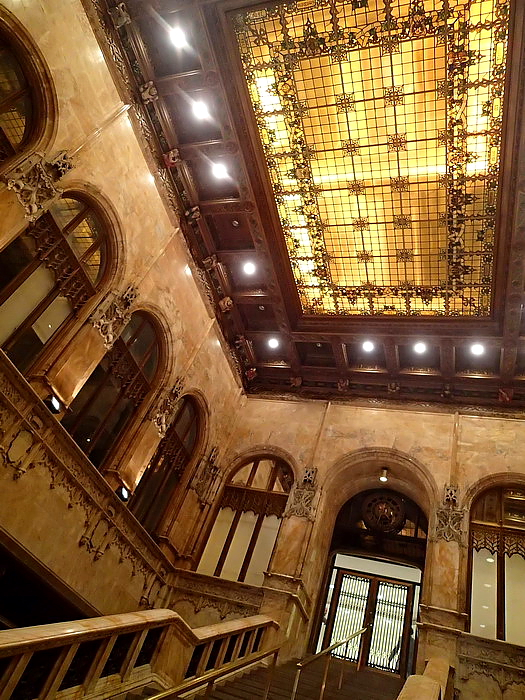

At the northern side of City Hall Park is the City Hall, the centre of city governance. Some areas of the city hall can be visited. Walking on we reach the office buildings on the corner of Centre and Lafayette. Here is the pillared United States Courthouse (40 Centre Street), the Municipal Building (1 Centre Street) and the Surrogate’s Court (corner of Chamber and Centre Street). Going north on Centre Street we arrive to the Civil Court Building (111 Centre Street). Mainly criminal trials and hearings take place in this building. If you’re interested you can sit in a trial but first you have to ask for permission in the office.

The area’s underground sight is the one-time City Hall metro stop which we can see from metro line 6 going south if we don’t get off at the final stop – City Hall-Brooklyn Bridge – but turn around with it.

